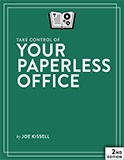Do you see piles of paper on the floor, stacks of folders teetering on your desk, and file cabinets lurking in the corners? If you feel like you’re drowning in a sea of paper, let author Joe Kissell help clear some of that clutter with the guidance in his latest ebook, the 147-page, US$10 “Take Control of Your Paperless Office, Second Edition” (http://tid.bl.it/tco-paperless-office).
He has lived a nearly paperless life for years. Under Kissell’s direction, you can develop a personal clean-up strategy and choose your tools: a document scanner and the software you need to perform OCR (optical character recognition); devices and services for storing digitized documents; and software to categorize, locate, and view digital documents.
Once you have your gear in hand, the author shows you how to convert paper documents to digitized files and gives you ideas for how to organize your office workflow, explaining how to develop day-to-day techniques that reduce the amount of time you spend pressing buttons, launching software, and otherwise managing your war on clutter.
If you’ve already embarked on a campaign to reduce the amount of paper in your life, Kissell even has a chapter about reassessing your paperless strategy, to make sure you’re working as effectively as possible given recent changes in software, services, and paraphernalia.
In addition to all of the above, he clues you in to these paper-reducing skills:
° Scanning or photographing documents you find while out and about — business cards, receipts, menus, flyers, and labels — so you keep only digitized versions. Kissell discusses several mobile scanning options, with an emphasis on using a camera-equipped iOS device, and he lists similar options for Android, Windows, and BlackBerry smartphones.
° Creating a digitized image of your signature so you can sign documents digitally, rather than printing them for the sole purpose of signing them with a pen.
° Setting up your computer to send and receive faxes so you can avoid using a physical fax machine with paper input and output. Joe describes online fax services and using a fax modem.
° Common techniques for reducing paper — paperless billing, online bank statements, and more — and less common practices, such as paperless postal mail services and check depositing services. Joe also shares effective tips for reducing the amount of catalogs, junk mail, and paper that you receive.


